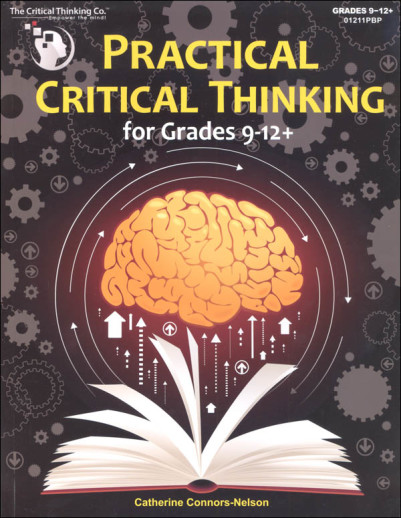We use cookies to make your experience better. To comply with the new e-Privacy directive, we need to ask for your consent to set the cookies. Learn more.
Practical Critical Thinking: Student Book
Practical Critical Thinking engages students in the study of critical thinking. It lays a strong foundation in the important cognitive skills necessary for critical thinking, such as comprehension, analysis, evaluation, construction, creativity, and communication. Through fun and concrete activitiesincluding Thought Experiments, Student Polls, Practice Sessions, Games and Puzzles, Predictions, and Important Takeawaysstudents explore topics essential to critical thinking, filling their Critical Thinking Tool Box with tools that will help them as critical thinkers, and applying critical thinking directly to their own lives. Additional individual and group activities are included to reinforce student learning as they explore topics such as:
The Basics of Critical Thinking
Obstacles to Critical Thinking
Evaluating Evidence
Creative Problem-Solving
Ambiguity, Vagueness, and Doublespeak
Arguments
Informal Fallacies
Advertising
Eyewitness Testimony, Direct & Circumstantial Evidence
Critical thinking is "the use of reason in our decisions about what to do and what to believe." Starting from such a definition, it's easy to see how critical thinking skills will impact every aspect of our lives and why it might be necessary to include a course in "practical critical thinking" in your high school curriculum. This course is designed for high school teens - ready to embark on a lifetime of decision-making - and seeks to arm them with quality tools for the journey. Heavily drawing from formal logic, this course seeks to apply those skills to every aspect of a student's world - advertising and eyewitness testimony, to name just a few.
The Student Book is a consumable worktext sprinkled with color photos and illustrations. Students are constantly asked to interact with pictures and articles and often asked to make their predictions. After a general introduction, the author uses logic and reasoning puzzles as a "hook" and motivation to enter the world of thinking. The course is divided into four units, each with two chapters. Unit 1 is the introduction and puzzles mentioned earlier. Unit 2 covers some foundational aspects of thinking skills, giving special attention to thinking and language. Unit 3 provides aspects of formal logic - arguments and fallacies. Unit 4 applies these more formal ideas to current situations, looking at both advertising and evidence. Instruction is written directly to the student and the text provides instructional segments interspersed with examples, requiring interactive responses. Answers are provided in the Teacher's Manual. For objective questions, there are objective answers. However, where "answers may vary," the TM provides "talking points" so you, the teacher, can evaluate the student response and lead a profitable discussion. The Student Text is reproducible for classroom use. However, the TM provides reproducible worksheets that duplicate the text so you might want to choose to reproduce those instead. You will need both the Student Text and the Teacher's Manual, however, as only the Student Text contains instructional material and only the TM contains the answers. While formal logic often seems like a foreign language with little application to real life, you'll not hear those complaints here. Each example, each application, each problem presented will seem familiar: grounded in a student's experience. This engaging course will give your student tools by which he can interpret and interact with the world around him. Student Book - 378 pgs, pb. Teacher's Manual - 296 pgs, pb ~ Janice
| Product Format: | Paperback |
|---|---|
| Grades: | 7-12 |
| Brand: | Critical Thinking Company |
| ISBN: | 9781601446640 |
| Length in Inches: | 10.9375 |
| Width in Inches: | 8.5 |
| Height in Inches: | 1 |
| Weight in Pounds: | 2.5 |
Be the first to review this item


Recommended in The Well-trained Mind, 4th edition.
As a compliment to the text book